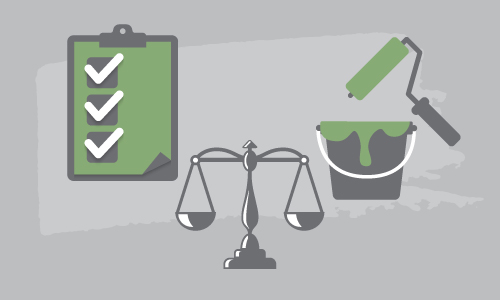For millennia, humans have left their mark on the world using three key ingredients—pigment, binder, and solvent. From the dawn of man to today, the methods and materials have evolved, additives have become prevalent, and manufacturing processes have improved, but the world of paint still relies on these three components.
The Paint Industry Evolves to Meet Evolving Regulations
However, just as materials and processes have evolved, so has the regulatory landscape. Concerns about the environment, worker safety, and consumer health have put immense pressure on the industry, and throughout the mid-20th century, regulators and lawmakers took aim at the paint industry—the Environmental Protection Agency, the Consumer Product Safety Commission, and the Occupational Safety and Health Administration all have set forth rules changing the way the paint and coatings industry worked.
To address this, paint manufacturers have worked hard to update their processes and materials to suit, implementing air pollution control solutions that destroy volatile organic compounds, hazardous air pollutants, and particulate matter.
However, with any regulatory compliance initiative comes increased cost: Pollution control solutions like oxidizers are by no means “cheap,” despite the improvements to efficiency made by manufacturers. Luckily, as an industry with steady, low concentration emissions despite high volume, there are many ways to decrease the cost of compliance.
Decreasing the Cost of Compliance in Paint Manufacturing
In addition to production improvements with pollution control in mind—increased paint transfer efficiency, automation, and reduced solvent usage to name a few—paint manufacturers have a variety of opportunities to collect, condense, and control emissions after production as well, all of which can drive down costs even further.
Ductwork and Airflow Planning: Efficiently Transporting Emissions
Paint manufacturing facilities are designed for efficient transfer of materials, mixing, and output of finished products, reducing costs and increasing output. Paired with this, the goal of pollution control is to make it as efficient, effective, and affordable as possible.
In order to do this, however, you need to find the best way to transport pollutants into the oxidizer itself. Not only does the solution need to collect polluted air from multiple points in a facility, it needs to move the air efficiently to reduce costs. At The CMM Group, we have helped companies like yours to discover the most efficient way to transfer polluted air for treatment, designing and implementing ductwork systems that efficiently transport polluted air for destruction. Learn more about our site engineering services here.
Dust Collection: Making a Rotary Concentrator a Reality
One of the biggest improvements to pollution control for paint manufacturers in recent decades has been the rotary concentrator. In combination with a regenerative thermal oxidizer, Rotary Concentrator Systems collect and condense emissions into a smaller airstream, allowing for the use of a smaller RTO.
However, in order to make this product a reality, dust needs to be removed from the airstream before it reaches the concentrator. While the Rotary Concentrator/RTO combination is the most effective way to provide savings and destruction efficiency for paint manufacturers, any dust or particulate must be filtered out of the emissions before reaching the concentrator, as this particulate can clog and destroy the wheel, rendering the system ineffective and out of regulatory compliance.
When you work with The CMM Group, we will help you to identify and install the right dust collection and filtration solutions to ensure that your concentrator operates properly.
The Rotary Concentrator/RTO Combination: Condense and Control
The rotary concentrator employs a concentrator wheel consisting of a hydrophobic Zeolite media in which the pollutants are passed through the concentrator and complete an adsorption/desorption process before the concentrated emissions are passed to an RTO for destruction.
This equipment benefits facilities as it can significantly reduce the size of the RTO being used to destroy a pollutant, in turn significantly decreasing operating costs.
Custom VOC Solutions form The CMM Group
Custom VOC abatement solutions can help you abide by environmental regulations, but you need to choose a reliable manufacturer. At The CMM Group, we specialize in manufacturing custom RTOs as well as alternative systems designed to control VOCs and other pollutants.
At The CMM Group, we have worked with paint manufacturers around the world to install pollution control solutions, improve the efficiency of VOC abatement, and ultimately save money. For example, we recently worked with the country’s largest paint manufacturer to design and implement a custom-fitted rotary concentrator system/RTO to handle a 50,000 scfm exhaust stream to efficiently meet regulatory compliance.
Get to know more about the work we do, read our free guide to VOC abatement in the paint industry, and contact us for a free consultation.




